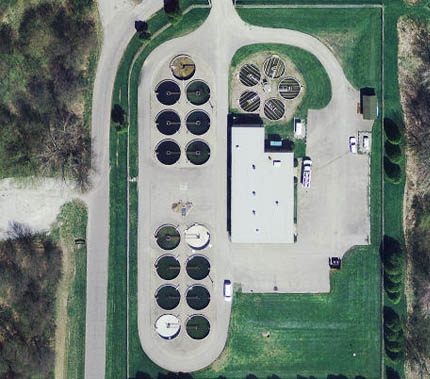- Mixsawbah State Fish Hatchery Alerts
- None at this time.
- Salmon - The Lake Michigan Story
In 1966, the state of Michigan stocked 600,000 young coho salmon into Lake Michigan tributaries. Biologists watched the progress of the cohos until they entered Lake Michigan. For the next several months, the fish vanished. stay offshore in cooler water preparing to return to their home streams each autumn.
The Indiana Department of Natural Resources began stocking salmon and trout fingerlings in the Indiana waters of Lake Michigan in 1968. In September, 1971, 25 Indiana-reared cohos were trapped from Trail Creek, and the first Hoosier salmon run was off to a flying start. About 10% of the original fish returned to Trail Creek.
The fish penetrated to the headwaters and spawned. Little success is expected from this natural reproduction, however, because natural survival is low in Indiana tributaries to Lake Michigan. This means the Lake Michigan salmonid program is totally manageable. The fishery is dependent on hatchery production and can be regulated by adjusting stocking numbers. Mixsawbah was built in 1974 to produce 500,000 trout and salmon annually to meet the demands of the new fishery.
Indiana state fish hatcheries do not sell fish.
- Water Supply

Water for the hatchery is supplied by three wells located about 3/4 mile west of the facility. One well provides operational water, while the remaining wells assume emergency standby positions. Water from the wells is 52°F., an excellent temperature for raising trout and salmon. Each well can supply 640 gallons per minute (gpm) to the building where the water passes through an aeration chamber to add oxygen. The aerated water is then pumped through mechanical filters to reduce the iron content. The filtered water is aerated again in the aeration chamber and overflows into a reservoir that supplies the egg incubators and the inside rearing tanks.
At full capacity, the inside system uses 300 gpm. Water not used for inside rearing overflows from the reservoir to a second storage basin that supplies the outside rearing ponds. Each outside pond uses up to 200 gpm. The operation of all 15 ponds requires 3,000 gpm. To make up the difference between the 640 gpm supplied from the well and the 3,000 gpm required, and to conserve water and energy, water is recycled.
The used water from the incubators, rearing tanks, and the rearing ponds is collected in biological filters located north of the building. The biofilters harbor bacteria; which convert ammonia, the major excretory product of fish, to harmless nitrates. The reconditioned water flows from the biofilters to a clearwell under the building where it is pumped up through an aeration chamber and overflows to the storage basin supplying the outside rearing ponds. When all 15 ponds are full, water will remain in the rearing pond recycle system for about 8 hours before it overflows to waste. Water leaving the hatchery is tested to meet federal, state and local water quality standards.
- Fish Rearing
Eggs are collected from adult fish returning to Indiana streams to spawn or are obtained through agreements with other states. At Mixsawbah, the eggs are disinfected to prevent the spread of disease prior to placing them in Heath Vertical Egg Incubators. The incubators provide a continuous flow of water and oxygen around each egg throughout the incubation process. There are 184 incubation trays at the hatchery, each capable of holding from 5,400 to 16,000 eggs, depending on the species. The eggs remain in the incubators about one month before they hatch. After hatching, the small fry remain in the trays for about 20 days, living and developing on the nutriments stored in their yolk sac. At the end of 20 days, the yolk is mostly absorbed and the young fry are ready to accept feed. At this time, the trout are transferred to the 18 inside rearing tanks, while the larger salmon are placed in the 15 outside rearing ponds.
The young trout remain in the rearing tanks for several months before they are transferred to the outside rearing ponds as 2.5 inch fingerlings. Each inside tank can hold 10,000, 2.5 inch fish. Each outside pond can hold 100,000, 3 inch fish or 16,500, 7 inch fish. Each rearing pond has a nameplate attached to the automatic feed hopper which identifies the species in that particular pond.
Fingerling salmonids are fed a nutritionally balanced, high protein diet from automatic feeders. Feed is dispensed every half hour for 18 hours per day. Salmonids readily learn to accept the artificial diet, but it is up to hatchery personnel to develop an efficient feeding program. Every hatchery manager wants to produce healthy fish with as little feed as possible. A trout must eat 1.25 pounds of food to gain one pound in weight. Fingerling salmonids are started on crumbles, a very fine granule the size of table salt. As the fish grow, the size of the feed particle is increased. Fish that are 6 inches in length can efficiently feed on 1/8 inch pellets.
Three species of salmonids are reared at Mixsawbah. Chinook salmon are stocked in the streams at five months of age or 3.5 inches in length. The other species are kept in the rearing ponds for 7-14 months where they grow to a size of 4.25 to 7 inches before being released.
- Volunteer Opportunities
Need a reason to get outside and move? You can volunteer alone or in small groups at this property. Some activities include trash pick-up, basic gardening, painting, and more. Call the property office for details.
